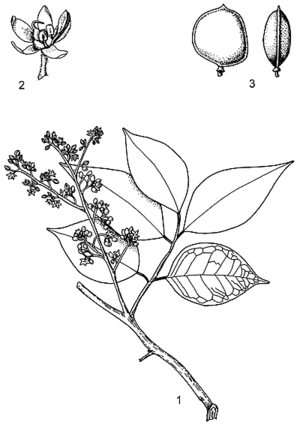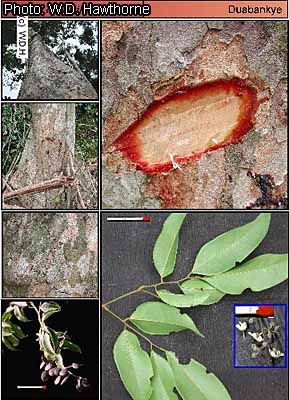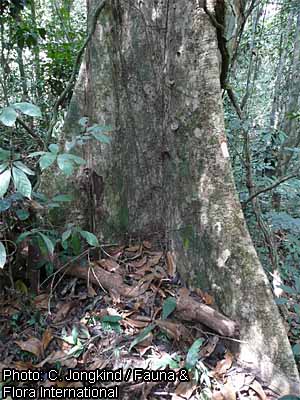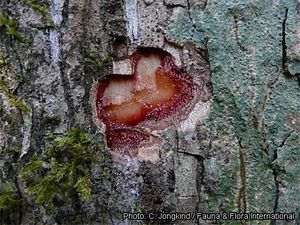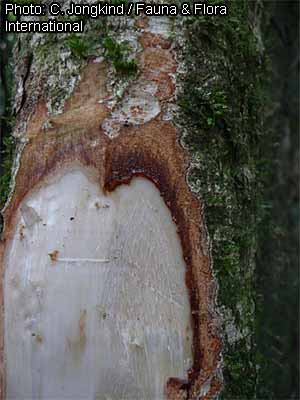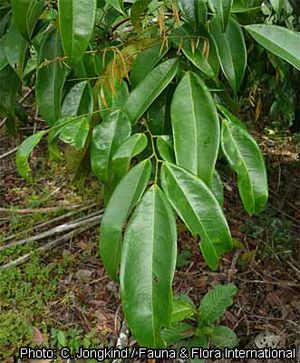Dialium aubrevillei (PROTA)
Introduction |
| General importance | |
| Geographic coverage Africa | |
| Geographic coverage World | |
| Fruit | |
| Timber | |
| Fuel | |
| Food security | |
Dialium aubrevillei Pellegr.
- Protologue: Bull. Soc. Bot. France 80: 463 (1933).
- Family: Caesalpiniaceae (Leguminosae - Caesalpinioideae)
- Chromosome number: 2n = 28
Origin and geographic distribution
Dialium aubrevillei occurs in Guinea, Sierra Leone, Liberia, Côte d’Ivoire and Ghana.
Uses
There are few recorded uses of the wood of Dialium aubrevillei. It is said that the use of the wood is limited because the boles are often short and crooked and because the wood is very hard. In Sierra Leone the wood is used for tool handles, but undoubtedly it is used for other purposes as well, similarly to other Dialium spp. It is suitable for heavy construction such as bridges, stairs and for poles and posts in house building, heavy flooring, mine props, ship building, vehicle bodies, railway sleepers, ladders, sporting goods, toys, novelties, vats and agricultural implements. In Sierra Leone the wood is used for charcoal production.
The slightly acidulous fruit pulp is edible.
Properties
The heartwood is pale brown to yellowish brown, often with reddish brown streaks, and distinctly demarcated from the greyish white to greyish yellow, up to 7 cm wide sapwood. The grain is usually straight, texture fine. The wood is heavy, with a density of 900–1050 kg/m³ at 12% moisture content, hard and tough. It air dries slowly and drying should be done with care to avoid warping and excessive surface and end checking. Proper stacking is needed, and it is recommended to quarter-saw logs for best results. The rates of shrinkage are quite high, from green to oven dry 5.2% radial and 10.4% tangential. At 12% moisture content, the modulus of rupture is 165–203 N/mm², modulus of elasticity 20,600–25,500 N/mm², compression parallel to grain 96–128 N/mm² and Janka side hardness 10,900–15,100 N.
The wood is difficult to saw due to the presence of silica; saw blades often heat up and stain the wood. The blunting effect on saw teeth and cutting edges is very high. The use of stellite-tipped saw teeth and tungsten-carbide cutting edges is recommended. It is difficult to work with both hand and machine tools, but planes to a good finish with a nice polish without the use of a filler. The wood has a tendency of splitting upon nailing and screwing, and pre-boring is recommended. It is durable, usually being very resistant to fungi and marine borers, and resistant to termite attacks. The heartwood is resistant to treatment with preservatives. The saw dust may cause irritation to mucous membranes in wood workers.
Description
- Evergreen medium-sized to fairly large tree up to 35(–65) m tall; bole branchless for up to 15(–30) m, straight or crooked, angular, up to 90(–120) cm in diameter, with small to fairly large buttresses up to 2 m high; bark surface scaly with small, irregular scales, greyish with yellowish brown patches, inner bark thin, brittle, yellowish outside, reddish inside, with a reddish, sticky exudate; crown rounded, dense; twigs with scattered lenticels, soon glabrous.
- Leaves alternate, imparipinnately compound with (3–)5 leaflets; stipules 2–3 mm long, caducous; petiole 1–3 cm long, rachis 3–5 cm long; petiolules c. 0.5 cm long; leaflets alternate, sometimes nearly opposite, obovate to elliptical, 4–13(–16) cm × 2–6 cm, cuneate to rounded at base, acuminate at apex, margins recurved, thick-papery, glabrous, pinnately veined with 4–9 pairs of lateral veins.
- Inflorescence a terminal or axillary panicle up to 15 cm long, short-hairy.
- Flowers bisexual, zygomorphic, fragrant; pedicel 2–3 mm long; sepals 5, free, triangular to broadly elliptical, c. 2.5 mm long, hairy; petal 1, spatulate, c. 2.5 mm long, pale yellow; disk c. 1.5 mm in diameter, finely hairy; stamens 2; ovary superior, ovoid, sessile, hairy, 1-celled, style curved.
- Fruit a nearly globose, flattened pod 1.5–2 cm in diameter, glabrous, black, with spongy pulp, indehiscent, 1(–2)-seeded.
- Seeds rounded, flattened, c. 1 cm long, brown, finely veined.
- Seedling with epigeal germination; hypocotyl 4–6 cm long, epicotyl 2–3.5 cm long; cotyledons fleshy, elliptical, up to 1.5 cm long, greenish; first leaves opposite, simple.
Other botanical information
Dialium comprises nearly 30 species and is pantropical. Approximately 15 species occur in mainland tropical Africa and 3 in Madagascar, whereas tropical Asia has about 7 species and tropical America one.
Apart from Dialium aubrevillei in West Africa and Dialium pachyphyllum Harms in Central Africa, several other Dialium spp. produce useful wood. For some of these, the use of their edible fruits is more important than that of the wood. This is the case for Dialium guineense Willd. from West and Central Africa, Dialium angolense Welw. ex Oliv. and Dialium englerianum Henriq. from Central and southern Africa, and Dialium schlechteri Harms from southern Africa.
Dialium bipindense
Dialium bipindense Harms (synonym: Dialium fleuryi Pellegr.) is a medium-sized tree up to 35 m tall with bole up to 100 cm in diameter, occurring in Cameroon, Equatorial Guinea and Gabon. Its reddish brown to dark brown wood, which is heavy, with a density of about 1070 kg/m³ at 12% moisture content, and very hard, is suitable for similar purposes as that of Dialium aubrevillei. It is also used as firewood and for charcoal production.
Dialium corbisieri
Dialium corbisieri Staner is a medium-sized to fairly large tree up to 35 m tall with bole up to 100 cm in diameter, occurring in Congo and DR Congo, and possibly Gabon. Its pinkish brown wood, which is heavy, with a density of about 1020 kg/m³ at 12% moisture content, and very hard, is suitable for similar purposes as that of Dialium aubrevillei. It is also used as firewood and for charcoal production.
Dialium dinklagei
Dialium dinklagei Harms is a small to medium-sized tree up to 20(–30) m tall with bole up to 50(–90) cm in diameter, occurring from Guinea and Sierra Leone eastward to Gabon and western DR Congo. Its wood is used for utensils; it is similar to that of Dialium aubrevillei and suitable for the same purposes. It is also used as firewood and for charcoal production. The fruit pulp is edible; a refreshing drink is made by maceration of the fruit pulp in water. The acid-tasting leaves are eaten as vegetable and to treat complaints of the respiratory organs, whereas leaf decoctions are taken as a treatment for jaundice, haematuria and fever. Bark infusions are applied as purgative and externally to treat arthritis.
Dialium zenkeri
Dialium zenkeri Harms (synonym: Dialium soyauxii Harms) is a small to large tree up to 40 m tall with bole up to 100 cm in diameter, occurring in Cameroon, Equatorial Guinea, Gabon, Congo and DR Congo. Its dark pinkish brown wood, which is fairly heavy, with a density of about 800 kg/m³ at 12% moisture content, and fairly hard, is suitable for similar purposes as that of Dialium aubrevillei. It is also used as firewood and for charcoal production. Dialium zenkeri is possibly conspecific with Dialium guineense Willd.
Dialium excelsum
Dialium excelsum Steyaert is a medium-sized to very large tree up to 50 m tall with bole up to 150 cm in diameter, occurring in DR Congo and Uganda. Its dark brown wood, which is heavy, with a density of about 910 kg/m³ at 15% moisture content, and hard, is suitable for similar purposes as that of Dialium aubrevillei.
Dialium pentandrum
Dialium pentandrum Steyaert is a medium-sized to large tree up to 40 m tall with bole up to 100 cm in diameter, restricted to DR Congo. Its pinkish brown wood, which is heavy, with a density of about 930 kg/m³ at 12% moisture content, and hard, is suitable for similar purposes as that of Dialium aubrevillei.
Dialium holtzii
Dialium holtzii Harms (called ‘mpepeta’ in Swahili) is a shrub or small to medium-sized tree up to 25 m tall, occurring in dry evergreen forest and riverine forest in eastern Tanzania and northern Mozambique. The heavy (density 785–835 kg/m³ at 12% moisture content), hard, brown wood with darker streaks is used for poles in construction, boat ribs, mortars and tool handles, and as firewood and for charcoal production. The whitish fruit pulp is edible; a refreshing drink is made by maceration of the fruit pulp in water with sugar.
Dialium orientale
Dialium orientale Baker f. (also called ‘mpepeta’ in Swahili) is a small tree up to 12(–18) m tall with short bole, occurring in dry evergreen forest and wooded grassland in southern Somalia, eastern Kenya and north-eastern Tanzania. The heavy (density about 930 kg/m³ at 12% moisture content), hard, reddish brown wood is used for poles in construction, joinery, furniture, boat ribs, mortars and tool handles, and as firewood and for charcoal production. The whitish fruit pulp is edible; a refreshing drink is made by maceration of the fruit pulp in water with sugar, and the pulp is also used for flavouring porridge and beer.
In Madagascar 3 Dialium spp. are found, and the wood of all these is used.
Dialium madagascariense
Dialium madagascariense Baill. is a medium-sized tree up to 30(–40) m tall with bole up to 100 cm in diameter, occurring in humid evergreen forest in eastern Madagascar. The heavy and hard wood is used in construction of houses and bridges, and for carpentry; the boles are used to make dug-out canoes. In traditional medicine, bark and roots are used in preparations to reduce tension.
Dialium occidentale
Dialium occidentale (Capuron) Du Puy & R.Rabev. is a medium-sized tree up to 20 m tall with bole up to 90 cm in diameter, occurring in seasonally dry deciduous forest in western and central Madagascar. The heavy and hard wood is used for construction and carpentry.
Dialium unifoliolatum
Dialium unifoliolatum Capuron is an evergreen medium-sized tree up to 30 m tall with bole up to 100 cm in diameter, occurring in humid evergreen forest in eastern Madagascar. Its wood is also used for construction.
Growth and development
In Liberia trees of Dialium aubrevillei flower from July to October, and fruits ripen about 6 months after flowering. The sweetish fruit pulp is eaten by monkeys, which possibly disperse the seeds.
Ecology
Dialium aubrevillei occurs scattered in evergreen and moist semi-deciduous forest, up to 500 m altitude. It is occasionally found in secondary forest. It is most common on hills and seems to avoid swampy locations. It prefers regions with an annual rainfall of 1500–2000 mm and base-poor acid soils.
Propagation and planting
Natural regeneration is most abundant in undisturbed forest. Seedlings have been reported to prefer shade and mineral soils, and are often abundant in the vicinity of parent trees. There are about 4000 seeds per kg. Seeds may take 2 weeks to 3 months to germinate and the germination rate is moderate.
Management
In forest in Liberia, the average number of Dialium trees with a bole diameter of more than 60 cm has been estimated at 0.1–0.3 per ha, whereas the wood volume has been estimated at 0.7 m³/ha for trees with a bole diameter of more than 50 cm. In Ghana Dialium aubrevillei is locally quite common.
Harvesting
The minimum bole diameter allowed for harvesting in Ghana is 70 cm.
Handling after harvest
Conversion of the logs after harvesting is not easy because of the hardness and high silica content of the wood. Special equipment is needed including bandsaws with stellite-tipped teeth. Even then, sawing operations give much waste and comparatively low yields of sawn wood.
Genetic resources
Dialium aubrevillei seems fairly common in at least some parts of its range, e.g. in Liberia and Ghana. Although it often occurs scattered and seems to prefer undisturbed forest, there are at present no indications of threats by genetic erosion. However, with the ongoing logging of forest in West Africa, it may become threatened in the near future.
Prospects
Dialium aubrevillei has been suggested as a substitute of azobé (Lophira alata Banks ex P.Gaertn.) because the wood is suitable for heavy construction for exterior use, but this seems to be unrealistic because azobé timber is more widely available and has superior characteristics. Dialium aubrevillei does not seem to have good prospects as a timber tree of commercial importance with sustainable production because it does not regenerate easily in disturbed forest.
The taxonomy of Dialium in mainland Africa is quite confusing, and a revision is badly needed.
Major references
- Aubréville, A., 1959. La flore forestière de la Côte d’Ivoire. Deuxième édition révisée. Tome premier. Publication No 15. Centre Technique Forestier Tropical, Nogent-sur-Marne, France. 369 pp.
- Burkill, H.M., 1995. The useful plants of West Tropical Africa. 2nd Edition. Volume 3, Families J–L. Royal Botanic Gardens, Kew, Richmond, United Kingdom. 857 pp.
- de la Mensbruge, G., 1966. La germination et les plantules des essences arborées de la forêt dense humide de la Côte d’Ivoire. Centre Technique Forestier Tropical, Nogent-sur-Marne, France. 389 pp.
- Dudek, S., Förster, B. & Klissenbauer, K., 1981. Lesser known Liberian timber species. Description of physical and mechanical properties, natural durability, treatability, workability and suggested uses. GTZ, Eschborn, Germany. 168 pp.
- Hawthorne, W.D., 1995. Ecological profiles of Ghanaian forest trees. Tropical Forestry Papers 29. Oxford Forestry Institute, Department of Plant Sciences, University of Oxford, United Kingdom. 345 pp.
- Holmgren, M., Poorter, L., Siepel, A., Bongers, F., Buitelaar, M., Chatelain, C., Gautier, L., Hawthorne, W.D., Helmink, A.T.F., Jongkind, C.C.H., Os-Breijer, H.J., Wieringa, J.J. & van Zoest, A.R., 2004. Ecological profiles of rare and endemic species. In: Poorter, L., Bongers, F., Kouamé, F.N. & Hawthorne, W.D. (Editors). Biodiversity of West African forests. An ecological atlas of woody plant species. CAB International, Wallingford, United Kingdom. pp. 101–389.
- Oteng-Amoako, A.A. (Editor), 2006. 100 tropical African timber trees from Ghana: tree description and wood identification with notes on distribution, ecology, silviculture, ethnobotany and wood uses. 304 pp.
- Rojo, J.P., 1982. Studies in the genus Dialium. PhD thesis, University of Oxford. 282 pp.
- Taylor, C.J., 1960. Synecology and silviculture in Ghana. Thomas Nelson and Sons, Edinburgh, United Kingdom. 418 pp.
- Voorhoeve, A.G., 1979. Liberian high forest trees. A systematic botanical study of the 75 most important or frequent high forest trees, with reference to numerous related species. Agricultural Research Reports 652, 2nd Impression. Centre for Agricultural Publishing and Documentation, Wageningen, Netherlands. 416 pp.
Other references
- Brenan, J.P.M., 1967. Leguminosae, subfamily Caesalpinioideae. In: Milne-Redhead, E. & Polhill, R.M. (Editors). Flora of Tropical East Africa. Crown Agents for Oversea Governments and Administrations, London, United Kingdom. 230 pp.
- Brummitt, R.K., Chikuni, A.C., Lock, J.M. & Polhill, R.M., 2007. Leguminosae, subfamily Caesalpinioideae. In: Timberlake, J.R., Pope, G.V., Polhill, R.M. & Martins, E.S. (Editors). Flora Zambesiaca. Volume 3, part 2. Royal Botanic Gardens, Kew, Richmond, United Kingdom. 218 pp.
- Bryce, J.M., 1967. The commercial timbers of Tanzania. Tanzania Forest Division, Utilisation Section, Moshi, Tanzania. 139 pp.
- Chikamai, B.N., Githiomi, J.K., Gachathi, F.N. & Njenga, M.G., undated. Commercial timber resources of Kenya. Kenya Forestry Research Institute (KEFRI), Nairobi, Kenya. 164 pp.
- CIRAD Forestry Department, 2009. Eyoum. [Internet] Tropix 6.0. http://tropix.cirad.fr/ africa/ eyoum.pdf. February 2012.
- du Puy, D.J., Labat, J.N., Rabevohitra, R., Villiers, J.-F., Bosser, J. & Moat, J., 2002. The Leguminosae of Madagascar. Royal Botanic Gardens, Kew, Richmond, United Kingdom. 750 pp.
- Fouarge, J., Quoilin, J. & Roosen, P., 1970. Essais physiques, mécaniques et de durabilité de bois de la République Démocratique du Congo. Série technique No 76. Institut National pour l’Etude Agronomique du Congo (INEAC), Brussels, Belgium. 40 pp.
- Fouarge, J., Sacré, E. & Mottet, A., 1950. Appropriation des bois congolais aux besoins de la métropole. Série Technique No 38. Institut National pour l’Étude Agronomique du Congo belge (INEAC), Brussels, Belgium. 17 pp.
- Hawthorne, W. & Jongkind, C., 2006. Woody plants of western African forests: a guide to the forest trees, shrubs and lianes from Senegal to Ghana. Kew Publishing, Royal Botanic Gardens, Kew, United Kingdom. 1023 pp.
- Lovett, J.C., Ruffo, C.K., Gereau, R.E. & Taplin, J.R.D., 2007. Field Guide to the moist forest trees of Tanzania. Frontier Publishing, United Kingdom. 303 pp.
- Maundu, P. & Tengnäs, B. (Editors), 2005. Useful trees and shrubs for Kenya. World Agroforestry Centre - East and Central Africa Regional Programme (ICRAF-ECA), Technical Handbook 35, Nairobi, Kenya. 484 pp.
- Normand, D. & Paquis, J., 1976. Manuel d’identification des bois commerciaux. Tome 2. Afrique guinéo-congolaise. Centre Technique Forestier Tropical, Nogent-sur-Marne, France. 335 pp.
- Okai, R., 2001. Assessment of sawing characteristics of three Ghanaian used-timber species. Proceedings of the 15th International wood machining seminar, July 30th – 1st August, 2001, Los Angeles, California, United States. pp. 261–269.
- Raponda-Walker, A. & Sillans, R., 1961. Les plantes utiles du Gabon. Paul Lechevalier, Paris, France. 614 pp.
- Ruffo, C.K., Birnie, A. & Tengnäs, B., 2002. Edible wild plants of Tanzania. Technical Handbook No 27. Regional Land Management Unit/ SIDA, Nairobi, Kenya. 766 pp.
- Sallenave, P., 1955. Propriétés physiques et mécaniques des bois tropicaux de l’Union française. Centre Technique Forestier Tropical, Nogent-sur-Marne, France. 129 pp.
- Sallenave, P., 1964. Propriétés physiques et mécaniques des bois tropicaux. Premier supplément. Centre Technique Forestier Tropical, Nogent-sur-Marne, France. 79 pp.
- Vivien, J. & Faure, J.J., 1996. Fruitiers sauvages d’Afrique: espèces du Cameroun. Ministère Français de la Coopération, Paris, France & CTA, Wageningen, Netherlands. 416 pp.
Sources of illustration
- Voorhoeve, A.G., 1979. Liberian high forest trees. A systematic botanical study of the 75 most important or frequent high forest trees, with reference to numerous related species. Agricultural Research Reports 652, 2nd Impression. Centre for Agricultural Publishing and Documentation, Wageningen, Netherlands. 416 pp.
Author(s)
- R.H.M.J. Lemmens, PROTA Network Office Europe, Wageningen University, P.O. Box 341, 6700 AH Wageningen, Netherlands
Correct citation of this article
Lemmens, R.H.M.J., 2012. Dialium aubrevillei Pellegr. [Internet] Record from PROTA4U. Lemmens, R.H.M.J., Louppe, D. & Oteng-Amoako, A.A. (Editors). PROTA (Plant Resources of Tropical Africa / Ressources végétales de l’Afrique tropicale), Wageningen, Netherlands.
Accessed 4 April 2025.
- See the Prota4U database.


